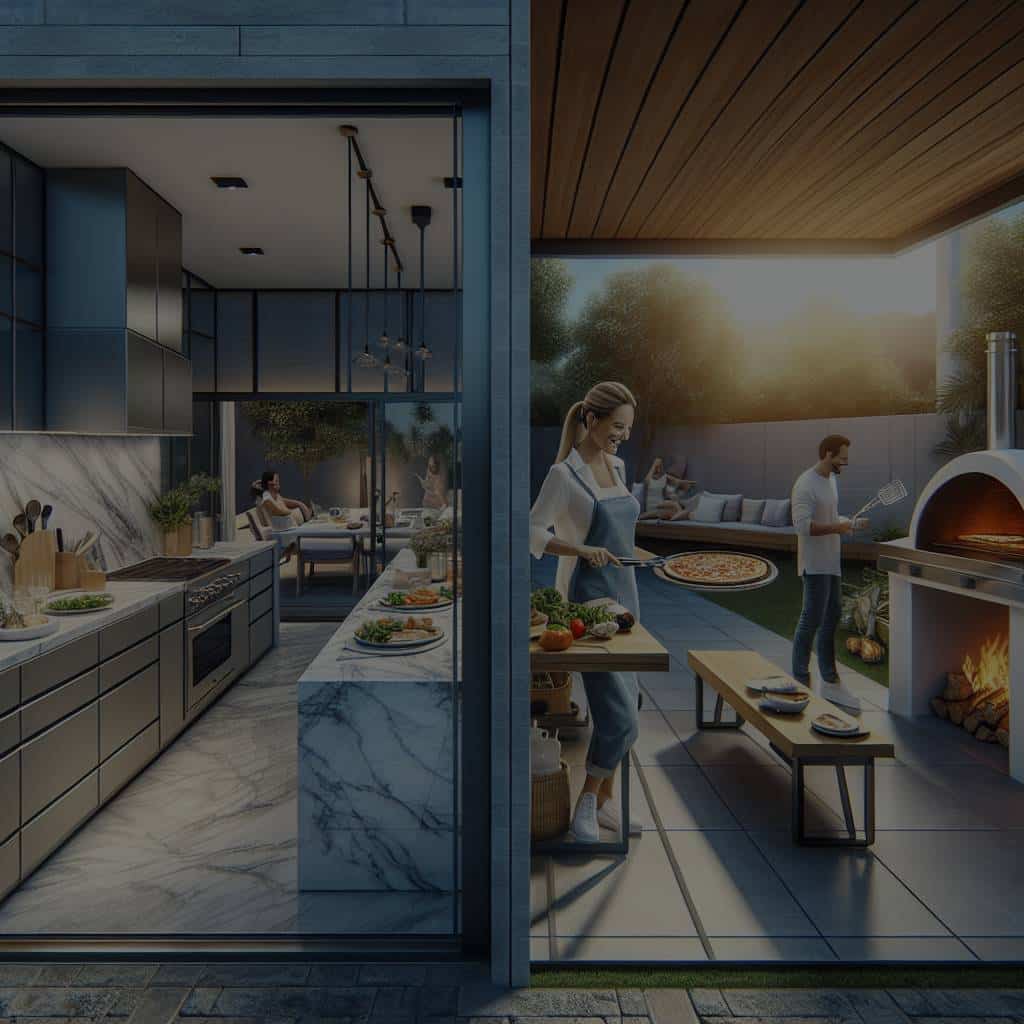What’s the Best Way to Create a Seamless Transition Between Indoor and Outdoor Kitchens?

In the modern era of design and architecture, there is a growing trend towards creating a seamless transition between indoor and outdoor living spaces. This trend is particularly prevalent in the design of kitchens, where the interior and exterior spaces often merge to function as one cohesive unit.
However, creating a seamless transition between your indoor and outdoor kitchens is no easy feat. It requires careful consideration of various design elements, a skilled blend of indoor and outdoor characteristics, and a harmonious integration of interior and exterior areas. This article will guide you through the process of creating a flawless transition between your indoor and outdoor kitchens.
A voir aussi : How Can You Design a Bullet Journalist’s Dream Workspace Filled with Creative Storage?
Understanding the Concept of Seamless Transition
Before we delve into the nitty-gritty of creating a seamless transition, it’s imperative to grasp what exactly the concept entails. A seamless transition between indoor and outdoor living spaces means these areas flow smoothly into one another, without a clear demarcation between the two. The objective is to establish a sense of continuity and fluidity that enhances the overall design and function of your kitchen.
When integrating your indoor and outdoor kitchens, consider elements like doors, windows, flooring, and textures. The choice of these elements can significantly impact how smoothly the two spaces transition to and from each other. For instance, large, glass sliding doors can effectively blur the lines between the indoor and outdoor areas, providing a clear view and easy access to both.
A voir aussi : How to Set Up a Home Art Studio with Perfect Natural Lighting for Painting?
Importance of Outdoor Living Spaces
Outdoor living spaces are increasingly becoming an integral part of modern homes. An outdoor kitchen extends your living space, offering a unique area for cooking, dining, and entertaining. Not only does it provide additional space, but it also allows you to enjoy natural elements and the outdoors in a comfortable and functional setting.
However, the outdoor kitchen should not just be an isolated area in your backyard. The goal is to make it a seamless extension of your indoor space. This can be achieved by ensuring a consistent design language, such as the use of similar materials, color schemes, and furniture styles in both areas. By doing so, you will create a sense of unity and harmony between your indoor and outdoor kitchens.
Designing a Seamless Transition
When it comes to designing a seamless transition, it’s all about integrating key design elements that link the indoor and outdoor areas. Here are some strategies to consider.
Consistent Flooring
The use of consistent flooring across your indoor and outdoor kitchens is a great way to create a seamless transition. By extending the same flooring material from your indoor to your outdoor kitchen, you will establish a visual continuity that blurs the boundary between the two spaces. However, keep in mind that the flooring material must be durable and weather-resistant to withstand the outdoor elements.
Large Glass Doors
As mentioned earlier, large glass doors are a fantastic element to implement in your design. They provide an unbroken view of the outdoor area while allowing plenty of natural light into the indoor space. Moreover, they create a physical connection between the two areas, making it easy to move between your indoor and outdoor kitchens.
Matching Furniture and Appliances
Matching your indoor and outdoor furniture and appliances can also contribute to a seamless transition. By mimicking the style and color scheme of your indoor kitchen in your outdoor area, you create a cohesive aesthetic that smoothly transitions from one space to the other.
Integrating Natural Elements
Finally, incorporating natural elements in your indoor kitchen can significantly help in establishing a seamless transition to the outdoor kitchen. Houseplants, a living green wall, or even a small indoor garden can mirror the outdoor greenery, thereby creating a visual link between the two spaces.
In addition, consider using natural materials such as stone, wood, or bamboo in your indoor kitchen design. These materials can harmonize with the outdoor landscape and architecture, further emphasizing the connection between interior and exterior spaces.
Creating a seamless transition between your indoor and outdoor kitchens is a thoughtful process that requires careful planning and design. However, with the right approach and the integration of key design elements, you can create a coherent, functional, and aesthetically pleasing kitchen space that effortlessly merges with the outdoors. The result is a unique indoor-outdoor kitchen experience that enhances your home’s living space and allows you to enjoy the best of both worlds.
Lighting and Climate Control for Seamless Transition
Understanding the role of lighting and climate control is pivotal to creating a seamless transition between your indoor and outdoor kitchens.
Lighting
Consider the natural light flow between your indoor and outdoor spaces and supplement it with artificial lighting. Carefully planned lighting design can create a sense of continuity between your indoor and outdoor kitchen. For instance, use the same style or type of light fixtures in both areas. You can also install dimmers to adjust the lighting according to the time of day or mood. Remember that outdoor lighting should be weather-resistant and capable of withstanding different climatic conditions.
Climate Control
Climate control is another aspect that can make or break the seamless transition between the indoor and outdoor kitchens. For areas with a mild climate, large glass doors can be left open most of the year, creating a constant flow between the indoor and outdoor spaces. However, in regions with extreme weather conditions, climate control can be challenging. In such cases, consider installing a retractable awning or roof over the outdoor kitchen. This can provide shelter from rain, snow, or intense sunlight and help maintain a comfortable temperature in the outdoor area. It’s also worth looking into outdoor heaters or fans, depending on the climate.
Investing in Durable Materials and Appliances
To establish a successful seamless indoor-outdoor kitchen, the use of durable materials and appliances is a must.
Materials
Whether it’s the countertops, cabinets, or flooring, the materials you choose should be able to withstand the outdoor elements. Materials like stainless steel, stone, and certain types of wood are hard-wearing and can endure varying weather conditions. Furthermore, these materials can also be used in your indoor kitchen to create a consistent look and feel.
Appliances
When it comes to appliances, opt for those designed explicitly for outdoor use. Appliances like grill stations, outdoor refrigerators, and weatherproof dishwashers not only enhance the functionality of your outdoor kitchen but also contribute to a seamless transition when matched with your indoor appliances.
Conclusion
Creating a seamless transition between indoor and outdoor kitchens is an art that requires careful planning, thoughtful design, and a keen eye for detail. By considering factors like the flow between the indoor and outdoor spaces, use of natural light, consistent design elements, and durable materials, you can create a harmonious blend of indoor and outdoor living areas.
Invest in high-quality, weather-resistant materials and appliances that can withstand the elements. Use lighting cleverly and consider climate control aspects to ensure comfort and functionality in all weather conditions. Finally, incorporate natural elements and maintain a consistent design language to enhance the sense of continuity between the two spaces.
With these tips in mind, you can create a unique, functional, and aesthetically pleasing kitchen space that combines the comfort of indoors with the freshness of outdoors. The result is a true extension of your living space that brings you the best of both worlds. Enjoy the process and the benefits of a well-designed indoor-outdoor kitchen.
